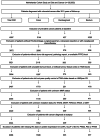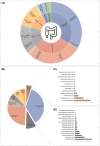Association between mutational subgroups, Warburg-subtypes, and survival in patients with colorectal cancer
- PMID: 35785488
- PMCID: PMC9883416
- DOI: 10.1002/cam4.4968
Association between mutational subgroups, Warburg-subtypes, and survival in patients with colorectal cancer
Abstract
Background: Previous research suggests that Warburg-subtypes are related to potentially important survival differences in colorectal cancer (CRC) patients. In the present study, we investigated whether mutational subgroups based on somatic mutations in RAS, BRAF, PIK3CA, and MET, which are known to promote the Warburg-effect, as well as mismatch repair (MMR) status, hold prognostic value in CRC. In addition, we investigated whether Warburg-subtypes provide additional prognostic information, independent of known prognostic factors like TNM stage.
Methods: CRC patients (n = 2344) from the prospective Netherlands Cohort Study (NLCS) were classified into eight mutually exclusive mutational subgroups, based on observed mutations in RAS, BRAF, PIK3CA, and MET, and MMR status: All-wild-type + MMRproficient , KRASmut + MMRproficient , KRASmut + PIK3CAmut + MMRproficient , PIK3CAmut + MMRproficient , BRAFmut + MMRproficient , BRAFmut + MMRdeficient , other + MMRproficient , and other + MMRdeficient . Kaplan-Meier curves and Cox regression models were used to investigate associations between mutational subgroups and survival, as well as associations between our previously established Warburg-subtypes and survival within these mutational subgroups.
Results: Compared to patients with all-wild-type + MMRproficient CRC, patients with KRASmut + MMRproficient , KRASmut + PIK3CAmut + MMRproficient , BRAFmut + MMRproficient , or other + MMRproficient CRC had a statistically significant worse survival (HRCRC-specific ranged from 1.29 to 1.88). In contrast, patients with other + MMRdeficient CRC had the most favorable survival (HRCRC-specific 0.48). No statistically significant survival differences were observed for the Warburg-subtypes within mutational subgroups.
Conclusion: Our results highlight the prognostic potential of mutational subgroups in CRC. Warburg-subtypes did not provide additional prognostic information within these mutational subgroups. Future larger-scale prospective studies are necessary to validate our findings and to examine the potential clinical utility of CRC subtyping based on mutational subgroups.
Keywords: Warburg-effect; colorectal cancer; oncogenes; prognosis; survival.
© 2022 The Authors. Cancer Medicine published by John Wiley & Sons Ltd.
Conflict of interest statement
HG has received honoraria from Astra Zeneca and BMS for scientific advisory board activities not related to the current study. The remaining authors have no conflicts of interest to declare.
Figures



Similar articles
-
Energy balance-related factors in childhood and adolescence and risk of colorectal cancer based on KRAS, PIK3CA, and BRAF mutations and MMR status.Mol Carcinog. 2022 Dec;61(12):1099-1115. doi: 10.1002/mc.23459. Epub 2022 Sep 30. Mol Carcinog. 2022. PMID: 36177801 Free PMC article.
-
Energy balance-related factors and risk of colorectal cancer based on KRAS, PIK3CA, and BRAF mutations and MMR status.J Cancer Res Clin Oncol. 2022 Oct;148(10):2723-2742. doi: 10.1007/s00432-022-04019-9. Epub 2022 May 11. J Cancer Res Clin Oncol. 2022. PMID: 35546360 Free PMC article.
-
LY3009120, a panRAF inhibitor, has significant anti-tumor activity in BRAF and KRAS mutant preclinical models of colorectal cancer.Oncotarget. 2017 Feb 7;8(6):9251-9266. doi: 10.18632/oncotarget.14002. Oncotarget. 2017. PMID: 27999210 Free PMC article.
-
The prognostic value of KRAS and BRAF in stage I-III colorectal cancer. A systematic review.Ann Ital Chir. 2019;90:127-137. Ann Ital Chir. 2019. PMID: 30739887
-
PIK3CA mutation and clinicopathological features of colorectal cancer: a systematic review and Meta-Analysis.Acta Oncol. 2020 Jan;59(1):66-74. doi: 10.1080/0284186X.2019.1664764. Epub 2019 Sep 23. Acta Oncol. 2020. PMID: 31545109
Cited by
-
N-Glycomic Profiling of Microsatellite Unstable Colorectal Cancer.Cancers (Basel). 2023 Jul 11;15(14):3571. doi: 10.3390/cancers15143571. Cancers (Basel). 2023. PMID: 37509233 Free PMC article.
-
Metabolic reprogramming in colorectal cancer: a review of aerobic glycolysis and its therapeutic implications for targeted treatment strategies.Cell Death Discov. 2025 Jul 14;11(1):321. doi: 10.1038/s41420-025-02623-5. Cell Death Discov. 2025. PMID: 40659604 Free PMC article. Review.
-
Novel drug resistance mechanisms and drug targets in BRAF-mutated peritoneal metastasis from colorectal cancer.J Transl Med. 2024 Jul 9;22(1):646. doi: 10.1186/s12967-024-05467-2. J Transl Med. 2024. PMID: 38982444 Free PMC article.
-
Prognostic and Predictive Value of SARIFA-status Within Molecular Subgroups of Colorectal Cancer: Insights From the Netherlands Cohort Study.Am J Surg Pathol. 2025 May 9;49(9):956-969. doi: 10.1097/PAS.0000000000002408. Am J Surg Pathol. 2025. PMID: 40340947 Free PMC article.
References
-
- Ferlay J, Ervik M, Lam F, et al. Global Cancer Observatory: Cancer Today: International Agency for Research on Cancer. https://gco.iarc.fr/today. Published 2020. Accessed 15 February, 2021.
-
- Bensinger SJ, Christofk HR. New aspects of the Warburg effect in cancer cell biology. Semin Cell Dev Biol. 2012;23(4):352‐361. - PubMed
Publication types
MeSH terms
Substances
Supplementary concepts
LinkOut - more resources
Full Text Sources
Medical
Research Materials
Miscellaneous

